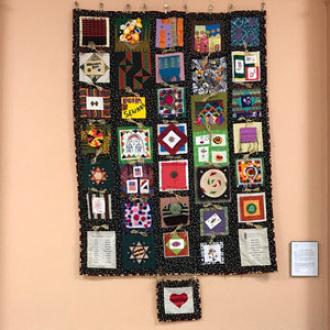
Bhim Subba, aged about 68, and another Subba clanmate, is the head of a large family of Nepali-speaking Bhutanese refugees in Worcester, resettling here in 2016. Several of us in the research team have visited his home in the Lincoln Street area many times for interviews and informal chats since 2017. Ellen Ferrante and Joan Kariko consider him a master artisan, operating at a very high level of technical and artistic excellence. Bhim and his wife Hungma, aged about 70, are both skilled artisans: Hungma weaves colorful textiles on a frame loom and makes small circular mats from corn husks; Bhim makes winnowing trays, baskets and remarkable bird cages, all of bamboo. Ellen and Joan tell us that his craftworking technique and level of precision in cutting his strips of bamboo are unparalleled in the Bhutanese refugee community in Worcester. He is highly respected among the Bhutanese families in the city (Rodgers and Umunna 2017, Path to Empowerment, pp. 16-17, Holy Crosss, Center for Liberal Arts in the World).
Like many Bhutanese families in Worcester the Subba’s pride in their culture is evident in the enthusiastic decoration of their home (the third floor apartment in a triple decker. Some of their grown children and their families live on the other floors). Yarn and pompom toran hang above interior doorways, their bristles brushing visitors’ foreheads with “good luck and fortune” as they enter the Subba home. Bhim and Hungma each have studios in the apartment for making their crafts. Bhim’s is in a sunny porch.
Bhim spends a considerable amount of time most days preparing lengths of bamboo for crafting and weaving his various artworks for sale through Refugee Artisans of Worcester. When asked about the future of Bhutanese bamboo crafts in Massachusetts, Bhim said he would be willing to teach his family members to work with this material if his kin expressed a desire to learn. If not, he thinks the craft will disappear. Some younger relatives have begun learning while working full-time or studying in school but they aver that Bhim is the true master bamboo weaver in the family.
In interviews Bhim focused conversation on his bamboo baskets and trays, not talking much about himself. In each of our discussions with him about artisanry an adult family member has acted as our English translator; Bhim does not speak English. While he is quiet he has a very strong presence in the room. He is observant and stands tall with his hands folded behind his back. During a 2022 trip to the experimental bamboo farm in Plymouth, MA, Bhim was focused on his bamboo but attentive when he grabbed a bamboo shoot that was about to fall towards the others (many were there that day on a bamboo harvesting trip).
He expresses a lot through his actions and also through costume. He makes a point to wear his topi cap, a traditional Nepali man’s accessory, for both formal occasions and everyday affairs. The topi’s geometric patterns are woven in similar ways by some of the community’s frame loom weaver women. While in the refugee camp in Nepal after being forced to leave their long-time villages in Bhutan, weavers would work in the camp craft house for piecework pay. They sometimes learned to weave in these styles while in the camp. Their goods would then be sold to manufacturers to be remade into topi caps for sale outside the camp, in Nepali markets and shops.
Bhim learned to prepare and weave bamboo in various styles while still a child. Working bamboo has been a constant for him through the good and the bad of the arduous refugee journey. In a 2022 visit to his home we learned from younger relatives that he is also a skilled and revered folk healer.
Joan recalled a visit to the Subba home one time when she was surprised to hear Bhim and a grown daughter singing in the latter’s second floor apartment. The young woman had been ill and apparently the condition was “more than” a simple doctor-style ailment. Joan entered the apartment and saw beautiful designs made of sand on the floor; Bhim was there performing a sand painting traditional diagnosis, singing and chanting. His daughter has since recovered. Friends, family and other Bhutanese refugees trust Bhim as a healer and come to him when they feel ill; they also see hospital treatment, thanks to the state medical insurance, MassHealth. Bhim is so well known and respected for his healing skills that he is sometimes summoned to refugee family homes as far away as Vermont. It is evident that Bhim is a leader, both for his exacting craftwork and for his healings. He had little to no access to formal schooling in his youth back in Bhutan but his skill levels, knowledge, and accomplishments are manifold.
